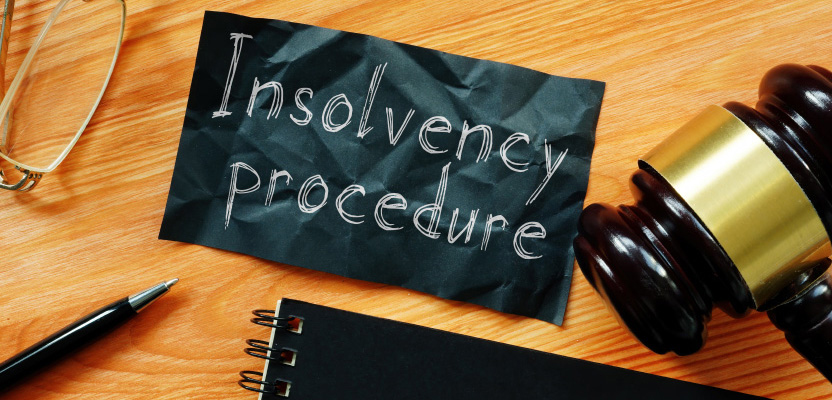This article aims to brief the owner-manager on the process for winding up an insolvent company.
The starting point: good independent, objective advice
Every day, business owners are grappling with the same problems of how to respond to cash flow pressures.
These may be caused by short term factors, such as a problem contract, or long term factors, such as increased competition or by positive factors such as the need for extra cash to provide working capital for new contracts.
Because cash flow problems are commonplace, there are people out there who can help you. Taking objective independent advice from a business advisor (such as an accountant or solicitor) or an insolvency practitioner will often be the first step that should be taken.
What is insolvency?
There are two sorts of insolvency. Balance sheet insolvency is where the company's liabilities exceed its assets. Cash flow insolvency is where a company cannot pay its debts as they fall due.
Cash flow insolvency can lead to balance sheet insolvency. If a company has to cease trading because it cannot pay its bills as they fall due, the value at which it is carrying its assets may need to be written down to their forced sale value instead of being shown at their going concern value.
Insolvency procedures
Administration
This procedure is equivalent to the 'Chapter 11' rescue procedure available in the USA.
It provides the company with protection from its creditors. This would prevent winding-up petitions from going further, and creditors such as landlords or asset leasing businesses from repossessing equipment or stock.
Administration can give the company breathing space to raise new funds, to perhaps reach agreement with its creditors on deferred (or reduced payment) of existing debts or, give time to sell the business.
The process involves an insolvency practitioner taking responsibility for the business. Directors lose their powers to run the company: a step that an owner-manager may not want to take lightly.
The overriding duty of the administrator is to save the business as a going concern, if possible. An administrator can be appointed by the company or by a bank holding a debenture. Since the Enterprise Act 2002 came into force, administration must be used (rather than administrative receivership) by banks holding debentures entered into after 15 September 2003, except for certain exceptional cases (e.g. capital market or PFI transactions).
Administrative receivership
An administrative receiver is an insolvency practitioner appointed by a bank (or other secured lender) who has taken a debenture with a floating charge; that is a general floating security over assets such as stock, machinery and (perhaps) book debts. He has power to run or sell the business and its assets.
The overriding duty of the administrative receiver is to pay off the bank (or other secured lender) who has appointed him.
Since the Enterprise Act 2002 came into force, the administrative receivership has been less commonly used. This is because (except for rare cases) banks who have taken debentures since 15 September 2003 must appoint an administrator whose job is to try to save the business, before it can be sold.
Corporate voluntary arrangement (CVA)
CVA is supervised by, but not controlled by, an insolvency practitioner. It can be used to compromise or settle creditor claims so that, for example, creditors receive a delayed payment or a reduced payment of so many pence in the pound.
The procedure involves the preparation of a proposal, and the convening of a creditors' meeting to vote on the proposal. A 75% vote (by value of debt held) of the creditors is needed for the proposal to be passed. It is then binding on all creditors. This can be a powerful procedure for a company running a business that has suffered an unexpected problem but is otherwise viable (e.g. a major bad debt).
Compulsory winding-up
This is the procedure taken by a creditor who is owed at least £750.
It is generally preceded by the issuing of a 21 day statutory demand. Failure to pay a bona fide debt after a 21 day written demand gives grounds to start the winding-up procedure by issuing a petition.
First a liquidator is appointed. This person is normally the Official Receiver, a civil servant. The role of the liquidator is to collect in the assets and pay off the debts of the company. He has ancillary powers to run the business but will not have the resources (or skills) of an administrator.
Members' voluntary liquidation
This is a procedure initiated by a (75%) vote of the shareholders of the company for the appointment of a liquidator. There are two varieties:
A creditors' voluntary liquidation (CVL), occurs when the directors are unable to make a declaration of solvency. The liquidator is usually an insolvency practitioner chosen by the directors but he or she can also be the Official Receiver if an insolvency practitioner is unavailable or unwilling to act.
A creditors' meeting is held and a creditors' committee appointed.
A members' voluntary liquidation, is the same as a CVL except that it is preceded by a directors' declaration of solvency and there is no need for the creditors' committee.
The role of the liquidator in either case is to collect in the assets and pay off the liabilities. The liquidator also has power to give up (or disclaim) onerous property such as an unprofitable contract or lease liabilities.
Further reading
Next you may want to read about directors duties when the company is in trouble.

